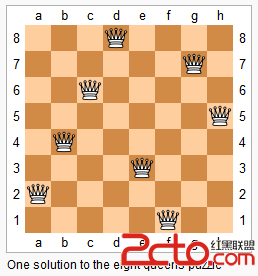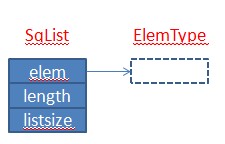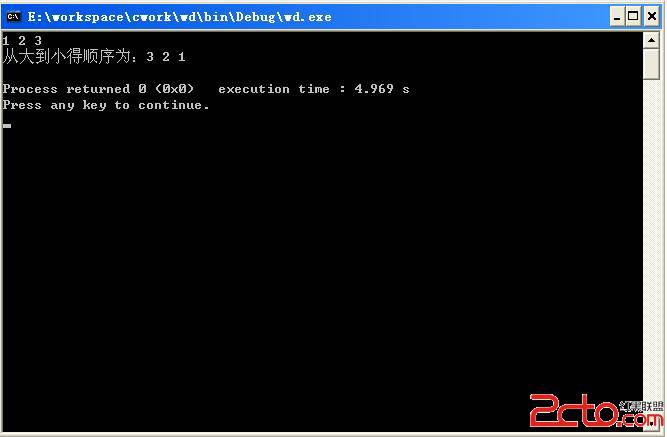线性表的顺序表示和实现
线性表的顺序表示和实现
Common.h
[cpp]
#define TRUE 1
#define FALSE 0
#define OK 1
#define ERROR 0
#define INFEASIBLE -1
#define OVERFLOW -2
typedef int Status;
#define TRUE 1
#define FALSE 0
#define OK 1
#define ERROR 0
#define INFEASIBLE -1
#define OVERFLOW -2
typedef int Status;
SqList.h
[cpp]
//------线性表的动态分配顺序存储结构--------
#include <stdlib.h>
#include "Common.h"
#define ElemType int
#define LIST_INIT_SIZE 100 //线性表存储空间的初始分配量
#define LISTINCREMENT 10 //线性表存储空间的分配增量
typedef struct{
ElemType* elem; //存储空间基址
int length; //当前长度
int listsize; //当前分配的存储容量(以sizeof(ElemType)为单位)
} SqList;
//基本操作
Status InitList(SqList &L);
//操作结果:构造一个空的线性表L。
Status DestroyList(SqList &L);
//初始条件:线性表L已存在。
//操作结果:销毁线性表L。
Status ClearList(SqList &L);
//初始条件:线性表L已存在。
//操作结果:将L重置为空表。
bool ListEmpty(SqList L);
//初始条件:线性表L已存在。
//操作结果:若L为空表,则返回TRUE,否则返回FALSE。
int ListLength(SqList L);
//初始条件:线性表L已存在。
//操作结果:返回L中数据元素的个数。
Status GetElem(SqList L, int i, ElemType &e);
//初始条件:线性表L已存在,1<=i<=ListLength(L)。
//操作结果:用e返回L中第i个数据元素的值。
int LocateElem(SqList L, int e, bool (*equal)(ElemType, ElemType));
//初始条件:线性表L已存在,compare()是数据元素判定函数。
//返回L中第一个与e满足关系compare()的数据元素的位序。若这样的数据元素不存在,则返回值为0.
Status PriorElem(SqList L, ElemType cur_e, ElemType &pre_e);
//初始条件:线性表L已存在。
//操作结果:若cur_e是L中的数据元素,且不是第一个,则用pre_e返回它的前驱,否则操作失败,pre_e无定义。
Status NextElem(SqList L, ElemType cur_e, ElemType &next_e);
//初始条件:线性表L已存在。
//操作结果:若cur_e是L中的数据元素,且不是最后一个,则用next_e返回它的后继,否则操作失败,next_e无定义。
Status ListInsert(SqList &L, int i, ElemType e);
//初始条件:线性表L已存在,1<=i<=ListLength(L)+1.
//操作结果:在L中第i个位置之前插入新的数据元素e,L的长度加1.
Status ListDelete(SqList &L, int i, ElemType &e);
//初始条件:线性表L已存在且非空,1<=i<=ListLength(L).
//操作结果:删除L的第i个数据元素,并用e返回其值,L的长度减1.
Status ListTraverse(SqList L, bool (*visit)(ElemType));
//初始条件:线性表L已存在
//操作结果:依次对L的每个元素调用函数visit().一旦visit()失败,则操作失败。
//------线性表的动态分配顺序存储结构--------
#include <stdlib.h>
#include "Common.h"
#define ElemType int
#define LIST_INIT_SIZE 100 //线性表存储空间的初始分配量
#define LISTINCREMENT 10 //线性表存储空间的分配增量
typedef struct{
ElemType* elem; //存储空间基址
int length; //当前长度
int listsize; //当前分配的存储容量(以sizeof(ElemType)为单位)
} SqList;
//基本操作
Status InitList(SqList &L);
//操作结果:构造一个空的线性表L。
Status DestroyList(SqList &L);
//初始条件:线性表L已存在。
//操作结果:销毁线性表L。
Status ClearList(SqList &L);
//初始条件:线性表L已存在。
//操作结果:将L重置为空表。
bool ListEmpty(SqList L);
//初始条件:线性表L已存在。
//操作结果:若L为空表,则返回TRUE,否则返回FALSE。
int ListLength(SqList L);
//初始条件:线性表L已存在。
//操作结果:返回L中数据元素的个数。
Status GetElem(SqList L, int i, ElemType &e);
//初始条件:线性表L已存在,1<=i<=ListLength(L)。
//操作结果:用e返回L中第i个数据元素的值。
int LocateElem(SqList L, int e, bool (*equal)(ElemType, ElemType));
//初始条件:线性表L已存在,compare()是数据元素判定函数。
//返回L中第一个与e满足关系compare()的数据元素的位序。若这样的数据元素不存在,则返回值为0.
Status PriorElem(SqList L, ElemType cur_e, ElemType &pre_e);
//初始条件:线性表L已存在。
//操作结果:若cur_e是L中的数据元素,且不是第一个,则用pre_e返回它的前驱,否则操作失败,pre_e无定义。
Status NextElem(SqList L, ElemType cur_e, ElemType &next_e);
//初始条件:线性表L已存在。
//操作结果:若cur_e是L中的数据元素,且不是最后一个,则用next_e返回它的后继,否则操作失败,next_e无定义。
Status ListInsert(SqList &L, int i, ElemType e);
//初始条件:线性表L已存在,1<=i<=ListLength(L)+1.
//操作结果:在L中第i个位置之前插入新的数据元素e,L的长度加1.
Status ListDelete(SqList &L, int i, ElemType &e);
//初始条件:线性表L已存在且非空,1<=i<=ListLength(L).
//操作结果:删除L的第i个数据元素,并用e返回其值,L的长度减1.
Status ListTraverse(SqList L, bool (*visit)(ElemType));
//初始条件:线性表L已存在
//操作结果:依次对L的每个元素调用函数visit().一旦visit()失败,则操作失败。
SqList.cpp
[cpp]
#include <malloc.h>
#include "SqList.h"
Status InitList(SqList &L){
//操作结果:构造一个空的线性表L。
L.elem = (ElemType *)malloc(LIST_INIT_SIZE * sizeof(ElemType));
if(!L.elem) exit(OVERFLOW); //存储分配失败
L.length = 0;
L.listsize = LIST_INIT_SIZE;
return OK;
}//InitList
Status DestroyList(SqList &L){
//操作结果:销毁线性表L。
free(&L);
return OK;





